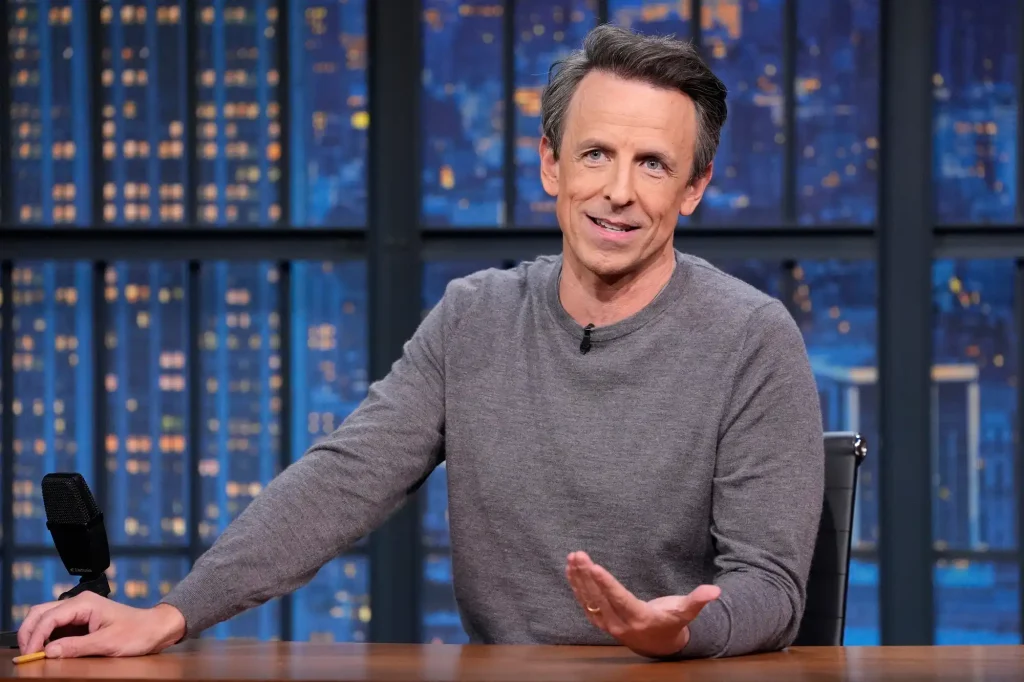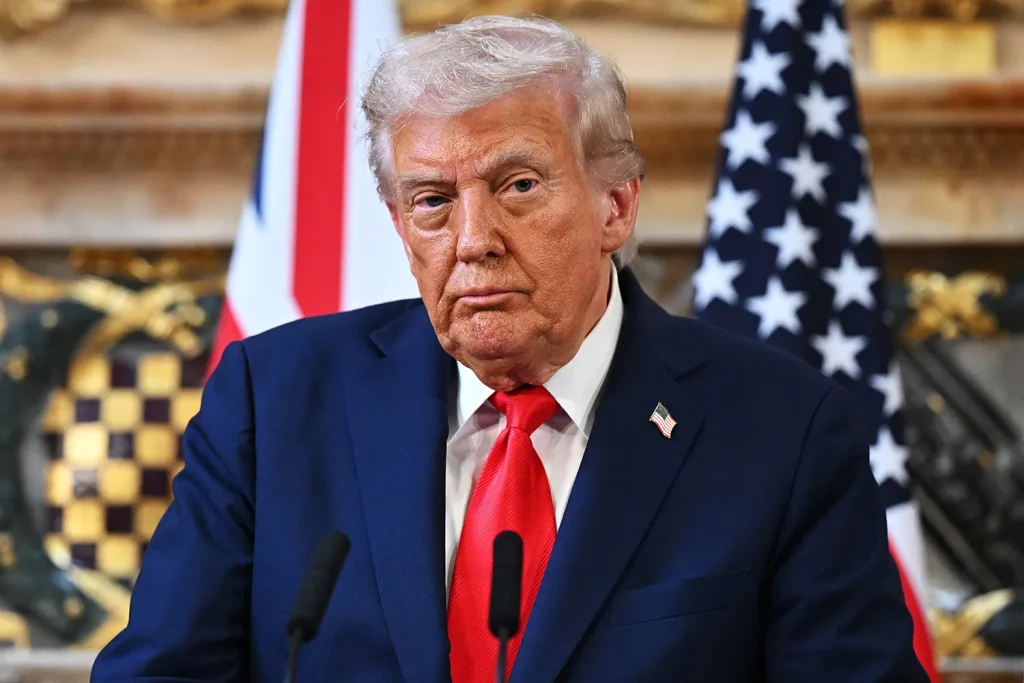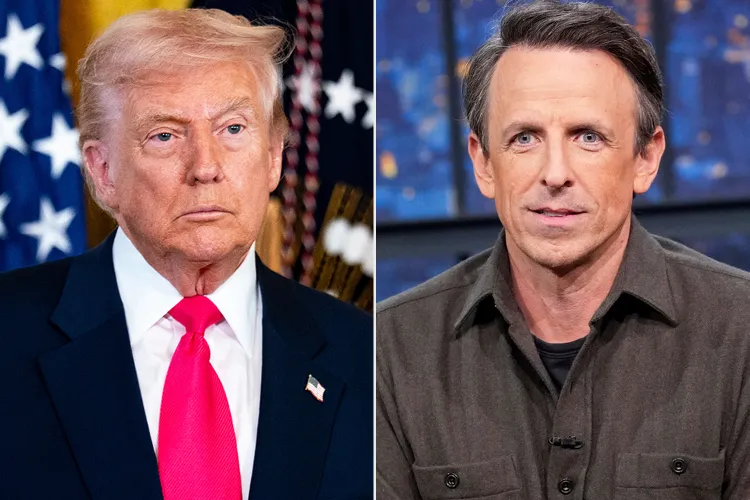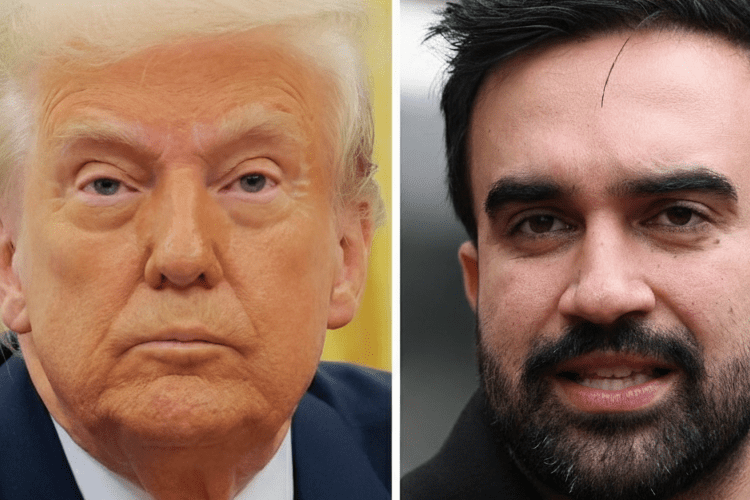Donald Trump Demands NBC Fire Seth Meyers — and the FCC Chair Publicly Amplifies It, Sparking a Media Firestorm
What began as another routine Truth Social post from Donald Trump quickly transformed into a political and media storyline that raised eyebrows across Washington and Hollywood. On November 15, the former president called for NBC to fire Late Night host Seth Meyers, accusing the comedian of having an “incurable case of Trump Derangement Syndrome.” It would have remained just another Trump-to-Hollywood feud, another moment in a long war of words between the politician and late-night television. But this time, something changed the tone of the exchange: the sitting chair of the Federal Communications Commission reposted Trump’s demand.

FCC Commissioner Brendan Carr, one of the most vocal critics of major entertainment corporations inside the U.S. communications regulatory structure, shared Trump’s statement on social media. That single act — a government regulator amplifying a politician’s call to remove a television host — immediately triggered debate about political pressure, First Amendment expectations, and the thin line between personal commentary and government influence.
Carr did not call directly for Meyers’ firing. He did not write a statement demanding consequences. But the repost itself was seen by many analysts as an implicit endorsement of Trump’s position. In an environment where the FCC oversees broadcast licensing, even symbolic alignment carries weight. Trump’s critics argued that the gesture felt like soft-pressure messaging from someone with regulatory power. Trump’s supporters called it a justified signal that late-night television has become openly partisan and hostile to conservative audiences. In truth, the situation sits somewhere between political theater and a decades-long cultural battle over what satire should look like.

The friction between Trump and Seth Meyers is not new. Meyers has built a significant part of his Late Night platform on monologues dissecting Trump’s political moves, legal troubles, and public remarks. During and after the 2016 campaign, Meyers’ “A Closer Look” segments became a staple for liberal audiences who viewed Trump through a critical lens. Meyers, unlike other late-night hosts, often takes on a news-anchor cadence — slow, analytical, measured — and then leans into deadpan humor that treats Trump’s public behavior as an ongoing civic warning. Some clips have reached tens of millions of views on YouTube and X. Trump has been aware of the criticism for years, and like his ongoing feud with Saturday Night Live, he occasionally chooses to respond.
On Saturday, he did more than respond. Writing on Truth Social, Trump said, “NBC’s Seth Meyers is suffering from an incurable case of Trump Derangement Syndrome (TDS). He should be fired immediately.” The post continued with criticism of NBC as a whole, returning to familiar Trump language about media bias, corporate corruption, and what he described as politically motivated programming disguised as comedy.
Then came the moment that elevated the story. Carr reposted the message. No commentary, no lengthy thread, just the former president’s demand appearing on the X account of an FCC regulator. Instantly, political commentators began calling attention to the move. Some claimed it signaled government interference in press freedom. Others argued that Carr was simply exercising his own speech rights.

A crucial distinction is worth noting: Seth Meyers’ show airs on NBC, which is a broadcast network regulated under FCC authority. The FCC cannot legally remove a host nor cancel a show based on political content. It also cannot pressure a network to fire an employee. Any attempt to do so would violate First Amendment protections. But symbolic actions, especially when amplified in political environments, often carry more cultural impact than legal action.
Carr himself has long positioned his platform as a watchdog against what he calls Silicon Valley censorship and mainstream media “disinformation.” He often speaks critically about Hollywood, tech companies, and federal content-regulation debates. In recent years, he has posted commentary supporting conservative complaints about media bias. What made this instance different was the optics: a direct amplification of a firing demand from a former president who remains the dominant figure in Republican politics and the leading candidate for the 2024 nomination.
NBC declined comment when major outlets reached out. Meyers has not addressed the situation publicly as of this writing, though it is likely to become monologue material. In the past, he responded to Trump’s criticisms with subtle humor rather than outrage. Meyers’ show format doesn’t rely on the kind of applause-breaking punchline structure seen on some late-night programs; instead, he builds entire segments around political and media analysis, weaving in jokes that land with viewers already aligned with his worldview.

The tension between Trump and late-night television goes far beyond this incident. During the Obama years, most comedy shows balanced critique evenly. That changed after 2016, when Trump’s presidency became the dominant subject of comedy news everywhere from broadcast networks to YouTube creators. Jimmy Kimmel, Stephen Colbert, and Seth Meyers shifted into more pointed political criticism. Trump’s response was equally pointed. He attacked hosts by name, mocked their ratings, and once suggested the FCC should examine whether shows like Saturday Night Live constituted “illegal election interference.” That suggestion had no legal grounding, but it demonstrated how personally Trump viewed the televised mockery.
What makes the Meyers dispute different is that a federal official put his digital signature on the message. Had Carr not reposted it, the story would likely have faded within hours. Instead, it sparked discussion among legal analysts asking where the boundary lies between political expression and regulatory intimidation. Former FCC staffers quoted in political publications noted that previous commissioners under both Republican and Democratic presidents avoided signaling personal alignment in public disputes over on-air talent. Even Ajit Pai, who was frequently criticized for reversing net neutrality rules, avoided engaging in public fights over individual hosts or comedians.
Those trying to read intent into Carr’s post face a challenge: the FCC lacks authority to enforce political content rules on broadcast comedy programs. Under long-standing First Amendment interpretation, satire enjoys the same protection as journalism. Meyers is free to criticize a presidential candidate. Trump is free to call him biased. Carr is free to express an opinion. But the symbolism remains powerful in a media environment where audiences increasingly believe institutions are picking sides.
Outside the political analysis, the public reaction mirrored the modern media divide. Conservative accounts celebrated Carr’s repost as a tacit acknowledgment that late-night television mocks Republican voters with impunity. Liberal commentators viewed it as proof that Trump-aligned officials may attempt to punish dissenting voices if political power shifts again. Some neutrals shrugged, noting that if Trump and Meyers have clashed for eight years already, another flare-up changes nothing.
The reality is that Meyers, like most of his late-night peers, operates in a changing media landscape. Ratings for broadcast late-night shows have fallen sharply compared to early 2000s numbers. Younger viewers consume monologues in clipped segments on TikTok and YouTube. That digital environment makes every moment searchable, replayable, and quotable. It also means that if Meyers chooses to respond, his rebuttal will likely become one of his most circulated clips.
Meanwhile, Trump will continue using Truth Social to project media battles. Of all modern presidents, he is the only one who treats late-night hosts as direct political adversaries rather than harmless entertainers. Whether audiences see that as strength or oversensitivity depends entirely on their broader views of him.
One thing is clear: Seth Meyers is unlikely to be fired based on Trump’s demand. NBC has weathered criticism before. The network kept Jimmy Fallon despite controversy, defended SNL during decades of political backlash, and rarely responds to critics calling for talent removal. Firing Meyers would mean conceding political pressure — something network executives have traditionally resisted to protect long-term integrity.
Still, the story has become bigger than a single post. Trump’s demand, amplified by a federal official, created a moment where cultural power, regulatory authority, political grievance, and comedic speech collided. It is a three-way spotlight: Trump pointing at Meyers, Meyers mocking Trump, and the FCC chair hovering behind them just long enough for everyone to take notice.
As the clip of the exchange circulates and Meyers’ audience waits to see whether his next monologue responds directly, the underlying message may be simpler than the politics suggest. The comedian continues speaking. The politician continues posting. And the viewers — on both sides — continue watching, waiting for the next punchline or pushback.
This story, like so many in modern media, is not about what government will do, but what audiences believe is happening. That alone is enough to keep millions of people refreshing their feeds, waiting for the next jab in one of America’s longest-running political comedy feuds — a feud that, today, unexpectedly includes the man who helps oversee the country’s broadcast system.



